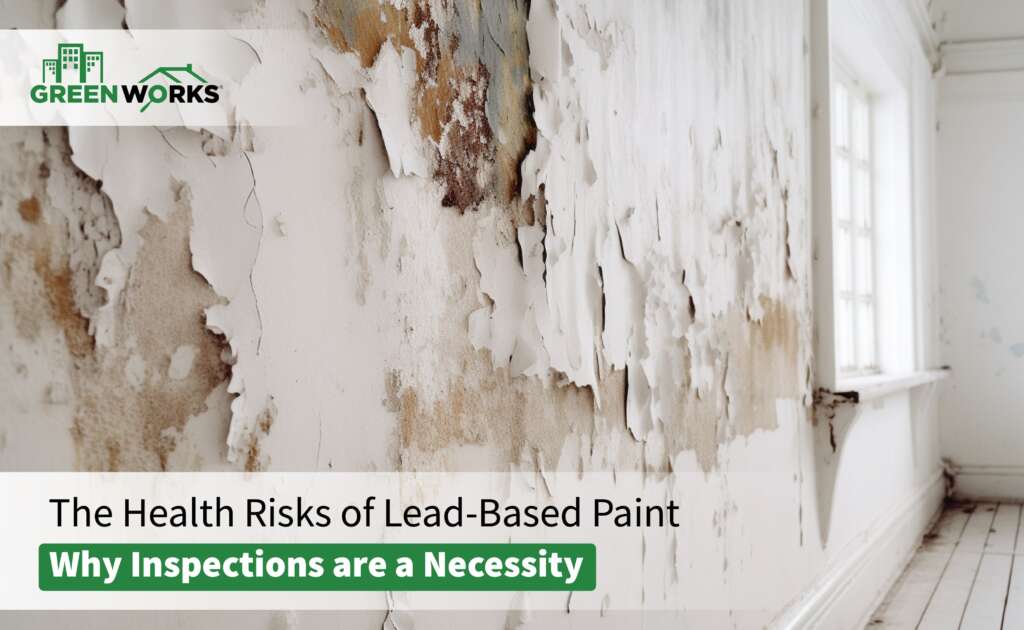Posts

The Health Risks of Lead-Based Paint: Why Inspections are a Necessity
You should look for lead-based paint if you reside in a house built before 1978. It is a silent hazard within your home that demands your attention or poses serious health risks. Women and young children are more at risk in this case.
There are many severe health issues that you can credit lead exposure for. From high blood pressure to nervous system damage, there is a chance that lead-based paint is to blame. Thus, understanding the risk of lead exposure and taking proactive measures is an important step.
This blog will explore the health risks associated with lead-based paint. We will also discuss how inspections can help mitigate this risk and how to identify lead paint.
Health Risks of Lead-Based Paint
Lead-based paint is mainly found in older properties. And this silent danger continues to threaten the health and well-being of countless individuals.
Neurological Damage
Lead is a potent neurotoxin and can impose harm to the nervous system. High levels of lead exposure can result in neurological damage you can’t reverse. This will lead to intellectual impairments, reduced IQ, and behavioral problems.
Behavioral and Learning Difficulties
As discussed above, children are at high risk of lead exposure. It can be linked to their behavioral and learning difficulties. These issues can increase aggression, hyperactivity, attention, and impulse control difficulties.
Gastrointestinal Distress
Gastrointestinal distress can also be caused by lead exposure. If you are experiencing symptoms like abdominal pain, constipation, and nausea, you might be exposed to lead.
Kidney Damage
This is another major risk of lead paint exposure.
High levels of lead exposure can damage the kidneys. Lead can be a reason behind impaired kidney function. While it also increases the risk of kidney disease.
Pregnancy and Fertility Risks
Pregnant women are also vulnerable to lead. Lead exposure during pregnancy can have grave consequences.
It may lead to premature birth, low birth weight, and developmental issues in newborns. Additionally, it can affect fertility in both men and women.
How to Identify Lead Paint?
Are you wondering what lead paint looks like? It can be any color, although it is mostly brown, grey, or white. However, based just on color, lead paint is difficult to distinguish. As a result, you can use numerous strategies, techniques, and ways to recognize lead-based paint. We go over a few of these below.
Historical Documentation
One of the initial steps in identifying lead paint is to determine the property’s age. If your home was constructed before 1978, there’s a higher likelihood of lead-based paint usage. You can also get insights into past renovations and paint usage through historical records and property documents.
Visual Inspection
A visual inspection can often reveal the presence of lead paint. Lead-based paint tends to have a distinct appearance, with characteristics like:
- Chalking: Lead paint can chalk as it ages, creating a powdery residue on surfaces.
- Alligatoring: The paint may develop an alligator-like pattern of cracks.
- Distinctive Color: Traditional lead paint colors are often white, off-white, or pastel shades.
- Cracking and Peeling: Older lead-based paint may crack or peel over time.
However, it’s essential to note that lead-based paint can be painted over with non-lead paint, making it less visible.
Testing Kits
Home testing kits are readily available and can provide a simple, quick method to determine the presence of lead in paint. These kits typically include swabs that change color when they come into contact with lead. While they can be helpful for a preliminary assessment, professional testing is recommended for confirmation.
Professional Inspection
Engaging a certified lead inspector is the most reliable method to identify lead paint. These professionals use specialized equipment and techniques to accurately assess the presence of lead-based paint in your home.
We will also discuss the significance of inspections for identifying lead paint later in this blog.
Risk Assessment
A certified risk assessor can conduct a more comprehensive evaluation of the lead-based paint’s condition. They can also assess potential exposure risks. This is particularly important if you have young children or pregnant individuals in the home.
XRF Testing
X-ray fluorescence (XRF) testing is an advanced method for detecting lead-based paint. It’s a non-destructive procedure that provides accurate results. Trained professionals operate XRF analyzers. These analyzers can identify the presence of lead with precision.
Lab Analysis
Sometimes, paint chip samples may be collected and sent to a laboratory for in-depth analysis. This method provides definitive results and can also determine the lead concentration in the paint.
The Role of Professional Inspections
Professional inspections play a central role in accurately detecting and assessing lead paint hazards. Their primary purpose is to ensure the safety of residents.
Below, we will discuss how these inspections help assess and identify lead paint within the house.
Certified Lead Inspectors
Certified lead inspectors are professionals trained in the identification of lead-based paint hazards. These professionals are knowledgeable, skilled, and certified to assess the presence of lead paint accurately. Thus, they can easily identify lead paint in residential and commercial properties.
Specialized Equipment
During the inspection, certified lead inspectors use specialized equipment and techniques. These go beyond the capabilities of home testing kits or visual inspections. These tools are designed to provide precise results, ensuring a thorough property evaluation.
Risk Assessment
Certified inspectors not only detect lead-based paint but also determine the associated risk. They consider factors such as the condition of the paint and its location within the property. They also check whether the lead threatens either children or pregnant women. This is because they are the most vulnerable to exposure.
Comprehensive Reports
After conducting inspections, certified professionals provide detailed reports. This report includes the findings, recommendations, and potential hazards. These reports are valuable references for property owners, buyers, and tenants.
Take the First Step to Safeguard Your Home and Loved Ones
Lead-based paint’s potential health hazards remind you of the value of regularly inspecting and maintaining your home. Particularly if you are purchasing or residing in an older house. While children and pregnant women are especially vulnerable to lead exposure.
Getting your home inspected is the first crucial step toward safeguarding the health and well-being of the residents.
Prioritizing inspections and adherence to lead safety standards is a collective responsibility. It can significantly impact the quality of life and the health of individuals and communities.
Experience the Confidence of a Safer Home! Schedule Your Inspection with Greenworks Inspections Today and Secure Your Peace of Mind.




